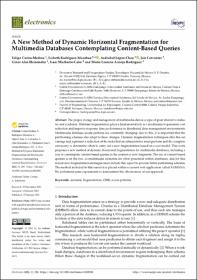| dc.contributor.author | Castro-Medina, Felipe | |
| dc.contributor.author | Rodríguez-Mazahua, Lisbeth | |
| dc.contributor.author | López-Chau, Asdrúbal | |
| dc.contributor.author | Cervantes, Jair | |
| dc.contributor.author | Alor-Hernández, Giner | |
| dc.contributor.author | Machorro-Cano, Isaac | |
| dc.contributor.author | Arrioja-Rodríguez, Mario Leoncio | |
| dc.date.accessioned | 2022-06-29T02:37:38Z | |
| dc.date.available | 2022-06-29T02:37:38Z | |
| dc.date.issued | 2022-01-17 | |
| dc.identifier.issn | 2079-9292 | |
| dc.identifier.uri | http://repositorios.orizaba.tecnm.mx:8080/xmlui/handle/123456789/586 | |
| dc.description | The proper storage and management of multimedia data is a topic of great interest to industry and academia. Database fragmentation plays a fundamental role as a mechanism to guarantee cost reduction and improve response time performance in distributed data management environments. Multimedia database access patterns are constantly changing; due to this, it is important that the partitioning schemes also adapt to these changes. Dynamic fragmentation techniques offer this advantage and represent a reduction of the tasks that an administrator must perform and the complete autonomy to determine when to carry out a new fragmentation based on a cost model. This work proposes a new method of dynamic horizontal fragmentation for multimedia databases, including a way to contemplate content-based queries in the creation of new fragments. The use of content-based queries is on the rise, as multimedia elements are often presented within databases, and for this reason new fragmentation strategies must include this aspect to provide better-performing schemas. The method included in this research is placed within a current web application called XAMANA. We performed some experiments to demonstrate the effectiveness of our approach. | es |
| dc.description.abstract | The proper storage and management of multimedia data is a topic of great interest to industry and academia. Database fragmentation plays a fundamental role as a mechanism to guarantee cost reduction and improve response time performance in distributed data management environments. Multimedia database access patterns are constantly changing; due to this, it is important that the partitioning schemes also adapt to these changes. Dynamic fragmentation techniques offer this advantage and represent a reduction of the tasks that an administrator must perform and the complete autonomy to determine when to carry out a new fragmentation based on a cost model. This work proposes a new method of dynamic horizontal fragmentation for multimedia databases, including a way to contemplate content-based queries in the creation of new fragments. The use of content-based queries is on the rise, as multimedia elements are often presented within databases, and for this reason new fragmentation strategies must include this aspect to provide better-performing schemas. The method included in this research is placed within a current web application called XAMANA. We performed some experiments to demonstrate the effectiveness of our approach. | es |
| dc.description.sponsorship | Fondo Sectorial de Investigación para la Educación (SEP-CONACYT),
Tecnológico Nacional de México (TecNM) | es |
| dc.language.iso | en_US | es |
| dc.publisher | MDPI Publishing | es |
| dc.relation.ispartofseries | Electronics; | |
| dc.subject | Dynamic fragmentation | es |
| dc.subject | CBIR | es |
| dc.subject | Access patterns | es |
| dc.title | A New Method of Dynamic Horizontal Fragmentation for Multimedia Databases Contemplating Content-Based Queries | es |
| dc.type | Article | es |



